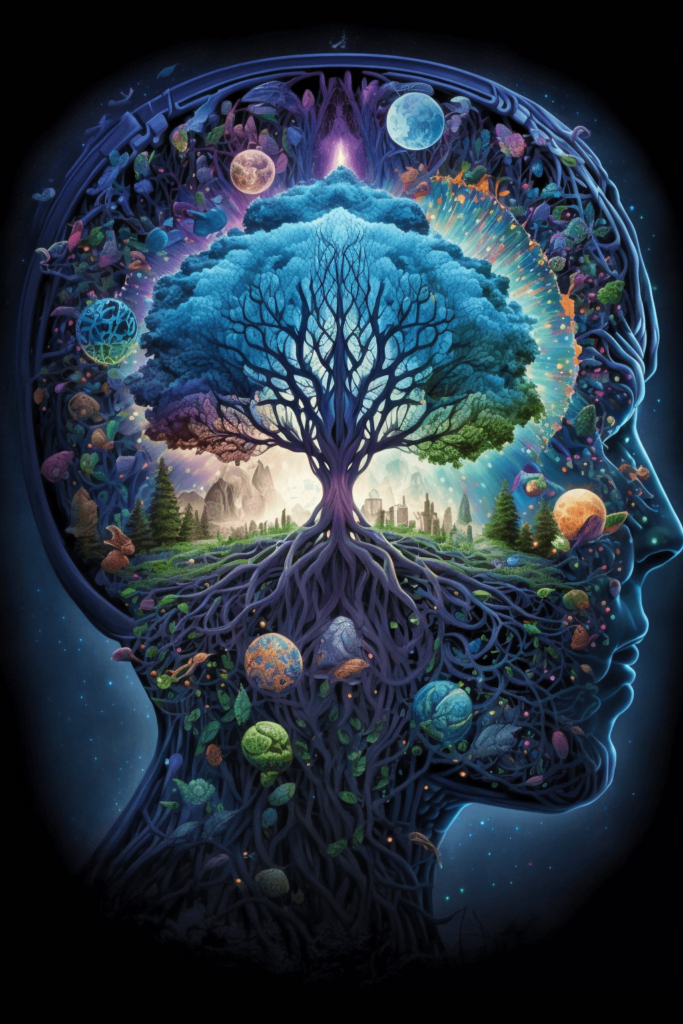Seven Hermetic Principles
The Hermetic principles, also known as the Seven Hermetic Principles or the Seven Laws of the Universe, originate from the “Kybalion,” a text published in 1908 authors under the pseudonym “the Three Initiates.” These principles draw their inspiration from the teachings of the ancient figure Hermes Trismegistus, often equated with the Greek god Hermes and the Egyptian god Thoth.
Hermes Trismegistus, meaning “Hermes the Thrice-Greatest,” is associated with profound wisdom and is said to have founded Hermetic philosophy. Although the historical existence of Hermes Trismegistus remains disputed, the teachings attributed to him, compiled in the “Corpus Hermeticum,” were instrumental in shaping Western alchemy, astrology, and magic.
Despite the considerable age of these attributed teachings, dating back to the Hellenistic period (1st to 4th centuries AD), “The Kybalion” presents them as timeless wisdom, providing a modern distillation of these ancient esoteric teachings. The Seven Hermetic Principles have significantly influenced various mystical, philosophical, and esoteric traditions, offering an interpretation of the universe’s nature and the interplay between its material and immaterial aspects. Here they are:

1. The Principle of Mentalism: This principle states that “All is Mind, The Universe is Mental.” This means everything that happens has to be a result of a mental state which precedes it. It suggests that reality is a mental construct and our perceptions and thoughts shape this reality.

2. The Principle of Correspondence: The famous line “As above, so below; as below, so above” encapsulates this principle. It means that there is a harmony, agreement, and correspondence between the physical, mental and spiritual realms.

3. The Principle of Vibration: This principle posits that “Nothing rests; everything moves; everything vibrates.” The differences between different manifestations of Matter, Energy, Mind, and Spirit, are the result of only different “vibrations.”

4. The Principle of Polarity: “Everything is Dual; everything has poles; everything has its pair of opposites.” This principle states that opposites are just different degrees of the same thing.

5. The Principle of Rhythm: This principle says that “Everything flows, out and in; everything has its tides.” This refers to the cyclical nature and rhythm found in the universe.

6. The Principle of Cause and Effect: “Every Cause has its Effect; every Effect has its Cause.” This principle states that nothing happens by chance, there’s always a reason for everything.

7. The Principle of Gender: “Gender is in everything; everything has its Masculine and Feminine Principles.” This principle means that masculine and feminine aspects exist in all things.
1. The Principle of Mentalism
The Principle of Mentalism is often phrased as “All is Mind, The Universe is Mental.” The key ideas behind this principle are as follows:
The nature of the universe: According to the Principle of Mentalism, the universe itself is a mental construct. Everything we perceive, experience, or conceive of is fundamentally rooted in the mind, or a universal consciousness, sometimes referred to as “The All” or “The Universal Mind.” This Universal Mind is considered the basis of all reality and existence.
The subjective reality: This principle suggests that reality is not an absolute entity but is subjective and varies from one individual to another. Our thoughts, beliefs, and perceptions shape our personal reality. Our interpretation of experiences, sensations, and interactions create the world as we know it.
Co-creation of reality: Given the universe is a manifestation of the mind, our individual minds have the power to influence and create our reality. This is often understood as the law of attraction; our thoughts and attitudes shape our experiences and reality.
Unity of all things: This principle also supports the notion of a unified universe, as all things are manifestations of a single Mind. This connects to the concept of oneness, suggesting that all things – living and non-living – are interconnected at a fundamental level.
It’s essential to remember that these interpretations and applications can vary between different schools of thought. This concept can be related to many philosophical and spiritual doctrines, including pantheism, idealism, and some interpretations of quantum physics.
It is a philosophical, metaphysical, and spiritual concept that provides a framework for understanding the universe from a particular perspective. It’s a way of understanding the world that emphasizes the power and primacy of the mental realm.
2. The Principle of Correspondence
The Principle of Correspondence is another one of the Seven Hermetic Principles outlined in “The Kybalion.” The principle is often summarized with the phrase: “As above, so below; as below, so above.”
Here are the key ideas behind this principle:
Mirroring of planes: The Principle of Correspondence asserts that there is a harmony, agreement, or correspondence between the several planes of existence – the physical, mental, and spiritual. This correspondence is used to understand and predict patterns across these planes. The phrase “As above, so below; as below, so above” suggests that what happens on any level of reality (physical, emotional, or mental) also happens on every other level.
Microcosm and Macrocosm: This principle refers to the idea that the same patterns are reproduced on all levels of the cosmos, from the largest scale (macrocosm or universe-level) all the way down to the smallest scale (microcosm or sub-atomic or even metaphysical-level). In other words, the structures and patterns seen in the wider universe are replicated on a smaller scale; for example, in human beings.
Understanding through analogy: This principle is used as a guide for human understanding. Humans can comprehend some aspects of the cosmos, the unknown, and the unseen by comparing it with known elements. It forms the basis of analogies and similes, and is a key part of the human method of reasoning and discovering. This is the basis for practices like astrology and tarot where microcosmic elements are used to represent the macrocosmic reality.
Manifestation of laws: The principle implies that the same universal laws apply to all levels of existence. Thus, understanding the laws that govern our own physical reality can give us insight into the laws that govern the cosmos, and vice versa.
It serves as a fundamental idea in various esoteric traditions, and also finds its parallels in modern physics, specifically in theories such as fractal geometry, holographic universe theory, and certain interpretations of quantum mechanics.
3. The Principle of Vibration
This principle is often phrased as: “Nothing rests; everything moves; everything vibrates.”
Here’s a detailed explanation of the principle:
Perpetual motion: The Principle of Vibration postulates that everything in the universe, at the most fundamental level, is in constant motion. Nothing is at rest. Every atom, particle, and molecule is in a state of constant movement.
Spectrum of vibration: It suggests that differences among various forms of matter, energy, mind, and even spirit, result from varying rates of vibration. From the highest form of spirit down to the grossest form of matter, everything is in vibration and has a frequency.
Transformation through vibration: The degree of the rate of vibration will affect the form of matter or energy. By altering the rate of vibration, you can change the form. This concept is key in alchemy, where transformation is a central theme.
Vibrational correspondence: In line with the Principle of Correspondence (“As above, so below; as below, so above”), the Principle of Vibration also suggests that this concept applies to the mental realm as well. Your mental state, your feelings and thoughts, also vibrate at certain frequencies, and these can be changed intentionally.
Law of Attraction: This principle is the underlying reason behind the law of attraction, where “like attracts like”. The vibrations of mental states can affect and influence other vibrations. Therefore, positive mental states will attract positive outcomes, and negative mental states will attract negative outcomes.
In modern science, parallels can be drawn with quantum mechanics, where particles are understood to exist in a state of probability until observed, and string theory, where the fundamental components of the universe are understood to be vibrating strings of energy. The principle also finds relevance in the study of sound and light, both of which travel in waves of vibration.
4. The Principle of Polarity
It’s typically encapsulated by the statement: “Everything is Dual; everything has poles; everything has its pair of opposites; like and unlike are the same; opposites are identical in nature, but different in degree; extremes meet; all truths are but half-truths; all paradoxes may be reconciled.”
The key aspects of the Principle of Polarity are as follows:
Dual Nature: Everything in the universe has a dual nature and can be separated into two parts. These can be opposites or contrasts, such as light and dark, hot and cold, high and low, love and hate, and so on. These are often referred to as polar opposites or simply “poles.”
Same Nature, Different Degree: Despite their differences, these opposites are only different in degree, not in kind. They lie on a continuum and are simply different points on that continuum. For example, heat and cold may seem opposite, but they are simply measures of the same thing (temperature) and differ only in degree.
Reconciliation of Paradoxes: The Principle of Polarity also states that all paradoxes can be reconciled. This suggests that what may seem to be contradictory or paradoxical can be resolved by considering it from the perspective of the Principle of Polarity. The reconciliation occurs when understanding that the two aspects are not opposing but are merely different degrees on a spectrum.
Transmutation: An understanding of the Principle of Polarity can be applied to enable transmutation from one state of being to another along a given pole or spectrum. This concept is crucial in Hermetic practices and has been applied in different ways in various esoteric traditions, like using mental alchemy to shift one’s perspective from despair to hope, for instance.
Parallels in Modern Science: The principle has parallels in many scientific concepts such as the existence of electric charge (positive and negative), the magnetic poles (north and south), and thermodynamics (hot and cold). It’s also seen in psychological terms, such as the continuum from love to hate, or joy to sorrow.
5. The Principle of Rhythm
It is often summarized as: “Everything flows, out and in; everything has its tides; all things rise and fall; the pendulum-swing manifests in everything; the measure of the swing to the right is the measure of the swing to the left; rhythm compensates.”
Here are the main points of this principle:
Cyclical motion: The Principle of Rhythm encapsulates the idea that there is a natural cycle and rhythm to everything in the universe. The tides go in and out, seasons change, day becomes night, and cycles of growth and decay are seen in all living things. This rhythm is fundamental to all levels of existence.
Balance and Compensation: The principle implies that there is always a reaction to an action, a rise for a fall, a swing forward and backward, and this is how balance and harmony are maintained in the universe. This principle can also be applied to mental states, suggesting that a person’s mental state will swing from happiness to sadness, from optimism to pessimism, and so on.
Predictability: This principle suggests that by understanding the rhythms of life, one can predict the cycles and patterns of events and phenomena. This knowledge can be used to prepare for future events or manipulate outcomes within certain boundaries.
Transcendence: While all things follow the Principle of Rhythm, it is believed in some esoteric traditions that it is possible to transcend the rhythmic swing of life to some extent through training and practice. This usually involves raising one’s consciousness or vibrations to higher planes and being aware of the rhythm in order to mitigate its effects.
Parallels in Modern Science: The principle has parallels in a variety of scientific concepts such as oscillations in physics (like pendulums and alternating current), cycles in biology (like life cycles and circadian rhythms), and economic cycles in sociology and economics.
6. The Principle of Cause and Effect
The Principle of Cause and Effect, also known as the Law of Cause and Effect, is another of the Seven Hermetic Principles as outlined in “The Kybalion”. The principle is often encapsulated by the phrase: “Every Cause has its Effect; every Effect has its Cause; everything happens according to Law; Chance is but a name for Law not recognized; there are many planes of causation, but nothing escapes the Law.”
Here are the key points of this principle:
Universality of causality: The principle asserts that nothing in the universe happens by chance or outside the universal laws. Every event, condition, or experience is caused by something and in turn causes something else to happen. This aligns with the deterministic view of the universe.
Plane of causation: There are different levels or planes of causation, but none escape the law. The planes of causation extend from the physical to the mental and spiritual realms. An effect on the physical plane may have its cause on the spiritual plane, and vice versa.
Avoidance of Chance: The principle states that what people often refer to as chance or coincidence is merely an effect for which they cannot identify the corresponding cause. It suggests that with complete knowledge, nothing would be accidental or unexpected.
Mastery and Transcendence: This principle suggests that by understanding the law of cause and effect, one can rise above the position of being merely an effect of other causes. Through mastering one’s thoughts, emotions, and actions, one can become a cause rather than an effect, shaping their reality rather than being shaped by it.
Parallels in Modern Science: The principle has parallels in a variety of scientific concepts. For instance, in physics, every action has an equal and opposite reaction according to Newton’s Third Law. Also, in biology, genetic traits cause certain effects in offspring.
7. The Principle of Gender
The principle can be summarized as: “Gender is in everything; everything has its Masculine and Feminine Principles; Gender manifests on all planes.”
This principle’s main points are:
Universality of Gender: The Principle of Gender postulates that gender, understood as masculine and feminine principles, is present in everything in the universe. It does not necessarily refer to biological sex, but rather to the dual nature of all things, which reflects the duality seen in male and female.
Masculine and Feminine Principles: The masculine principle is understood as being outwardly focused, active, logical, and analytical, often associated with the “giving” or “projective” aspect. The feminine principle is inwardly focused, receptive, intuitive, nurturing, and associated with the “receiving” or “absorptive” aspect. It is important to note that, according to this principle, all entities and individuals contain both masculine and feminine aspects.
Creation and Transformation: The Principle of Gender is seen as an essential principle for creation and transformation in the universe. The interaction of the masculine and feminine principles is seen as generating motion, change, and diversity.
Manifestation on All Planes: Just like the other principles, the Principle of Gender operates on all planes – physical, mental, and spiritual. On the mental plane, it can be related to the duality of conscious and subconscious, logic and intuition, or analytical and holistic thinking.
Personal Development: Understanding and balancing the masculine and feminine aspects within oneself is often considered a key aspect of personal development in spiritual and esoteric traditions.
In a universe so wide and vast,
A cosmic law, principles cast.
From the ether, a soft refrain,
The Principle of Mentalism reigns.
Thoughts, perceptions shape reality,
An echo of the mind’s duality.
Mirroring worlds, below, above,
Through the Principle of Correspondence we move.
Nothing rests, everything in tune,
A cosmic dance, a rhythmic rune.
Under the Principle of Vibration’s guise,
In diverse forms, the universe lies.
Polarity’s rule, a paradox spun,
Opposites meet, duality undone.
In every rhythm, a tide resides,
Under the Principle of Rhythm, life abides.
Every cause, every effect,
In an intricate cosmic network, they connect.
No act is chance, no fate astray,
Under the Principle of Cause and Effect, they lay.
The dance of the masculine, the feminine sway,
In all things, their balance play.
In each principle, a cosmic theme,
Through the Principle of Gender, we dream.







